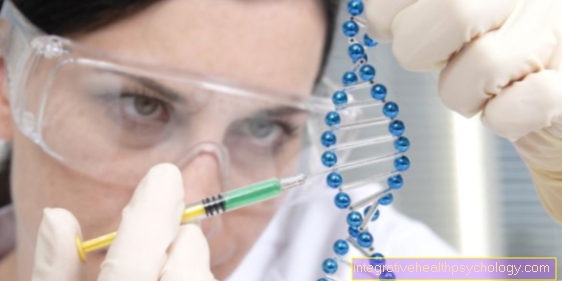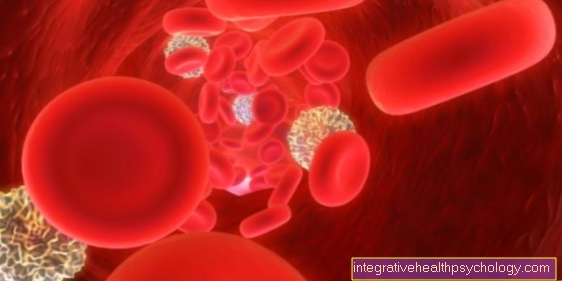beta HCG
definition
Human chorionic gonadotropin (HCG) is a hormone that is produced in the human placenta and plays an important role in maintaining pregnancy. The hormone consists of two subunits, alpha and beta, whereby only the beta subunit is characteristic, while the alpha subunit also occurs in other hormones.

function
The female cycle can be divided into two hormonal phases:
- In the proliferation phase, the first half of the cycle, high levels of estrogen (see also: Estrogen) causes the lining of the uterus to grow.
- After ovulation, on the other hand, there is a high level of progesterone in the second half of the cycle, which prepares the mucous membrane for the implantation of a fertilized egg cell. Progesterone also guarantees blood flow to the functional uterine lining. If the progesterone level drops towards the end of the cycle, the arterial vessels that supply blood to the mucous membrane close and menstruation occurs.
This cycle must be interrupted when a fertilized egg cell (blastocyst) is implanted. For this purpose, some cells of the blastocyst, the syncytiotrophoblasts, which develop into the child's part of the placenta, produce human chorionic gonadotropin. Like the luteinizing hormone (LH) of the pituitary gland, HCG has a stimulating effect on the corpus luteum in the ovary and maintains its estrogen and progesterone production.
In the case of pregnancy, the corpus luteum does not regress until the 12th week - the placenta is only able to produce sufficient progesterone itself to maintain the pregnancy at this point in time.
Furthermore, the high levels of estrogen and progesterone lead to the conversion of the uterine lining into the nutrient-rich decidua that initially nourishes the embryo. Negative feedback also prevents the release of stimulating hormones in the pituitary gland so that no further ovulation occurs.
Value in pregnancy
In the first weeks of pregnancy, the HCG concentration in the blood increases sharply until it reaches its maximum around the eighth week of pregnancy. After that, the concentration again drops to just under 20% of the maximum value, which is reached around the 28th week of pregnancy. The concentration is significantly lower before and after pregnancy.
diet
In 1954, British doctor Albert Simeons examined pregnant women who had a ultra-low calorie diet adhered to. He noted that when combining the diet with hCG injections the patients were more likely to lose fat than muscle tissue. Based on this observation, he recommended a restrictive diet with hCG injections. Since then, this method has come into fashion again and again and is advertised as the method of choice by Hollywood actors, for example.
It has never been proven that the intake of pregnancy hormones supports weight loss and hCG is not approved for this purpose. If the recommended 500 kilocalorie diet is strictly adhered to (for comparison: the daily calorie requirement of an adult is around 2000 kcal), any weight loss effect can be attributed to the negative energy balance of the body through diet.
However, it has been proven that such diets do not lead to long-term success (yo-yo effect) and the Risk of malnutrition in such radical diets is very large - with sometimes life-threatening consequences such as cardiac arrhythmias. In addition, the safety of hCG injections has not been adequately studied. The procurement of hCG on the Internet still carries the risk of acquiring preparations of poor pharmaceutical quality, which may contain other substances that are harmful to health. For this reason, from a medical point of view, hCG-based diets are strongly discouraged.
Tumor markers
Human chorionic gonadotropin is used diagnostically as a tumor marker, especially some malignant tumors Tumors of the gonads (Testicles and ovaries) and the placenta that produce the hormone. In rarer cases, this also applies to tumors in other tissues such as the mammary gland, liver, lungs or intestines.
However, like most tumor markers, HCG is used not as a diagnosis for the presence of a malignant diseasebut rather as a follow-up or prognosis parameters in the case of a tumor disease that has already been diagnosed. In the case of metastatic germ cell tumors of the testes, for example, the concentration of hCG is a characteristic that defines the prognosis as good, intermediate or bad. Higher serum levels are associated with a worse prognosis.
pregnancy test
Almost all pregnancy tests measure the level of hCG in the urine or blood. One week after fertilization, the blood level can be sufficient to determine the pregnancy via a laboratory test - i.e. before the menstrual period stops. After 2 weeks at the earliest, the concentration in the urine is so high that the hormone can be detected using the freely available pregnancy test.
The test works with the help of color-marked antibodies that specifically bind to hCG. A positive test usually shows two pink stripes, while a negative test shows only one.
The statement of a negative test result is only limited at this point - it can also take 5 to 6 weeks before the hormone can be detected in the urine. The concentration of hCG is highest in the morning urine, so that the morning is the best time for a pregnancy test.
A false positive result (i.e. a positive test if there is no pregnancy) can be triggered, for example, by an hCG-producing germ cell tumor. Therefore, a blood sample and an ultrasound examination should always be carried out after the test (see also: Ultrasound in pregnancy) respectively.





























